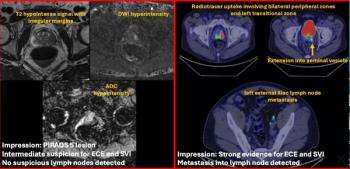Rectal Cancer MRI: Seven Key Takeaways from a New Literature Review
Noting a rapidly changing paradigm for the treatment of rectal cancers, the authors of a new literature review discuss current and emerging principles in MRI assessment and staging.
Emphasizing the key role of magnetic resonance imaging (MRI) in the assessment of patients with rectal cancer, researchers recently surveyed the literature to discuss the differentiation of rectal tumors, essential staging considerations and implications for treatment.
Here are seven pertinent takeaways from the newly published literature review in the
1. While acknowledging subjective determination of the “sigmoid take-off” (STO), researchers said the emerging use of this imaging landmark, which defines the junction of the sigmoid colon and rectum, led to a 17 percent improvement in interreader agreement in one study. Other research from 2022 demonstrated that incorporation of the STO landmark on MRI would have led to tumor reclassification for 28 percent of patients and corresponding changes to treatment plans for 82 percent of those patients.
2. Noting inaccurate endoscopic measurements of tumor height and common variability in employing the distal aspects of the internal and external anal sphincters to establish the anal verge (AV), the researchers said the intersphincteric groove may offer an appropriate landmark that can facilitate identification of the AV on MRI.
3. For patients on active surveillance after being treated with neoadjuvant therapy for locally advanced rectal tumors, a 2024 study revealed that 94 percent of these patients experience local regrowth of the tumor within two years.
4. While there may be challenges in T4b rectal tumor classification with respect to ascertaining tumor adherence versus abutment or contact of organs, the review authors suggested the absence of a fat plane between the tumor and adjacent organ may warrant wider resection due to potential risk for adhesive disease and/or microscopic tumor involvement.
5. When there is mesorectal fascia (MRF) involvement by the primary tumor, these patients reportedly have over double the tumor recurrence rate (42 percent) in comparison to those who have MRF involvement by extramural vascular invasion (EMVI) (22 percent). When there are lymph nodes (LNs) with smooth margins within 1 mm from the MRF, these patients have low tumor recurrence risk (0.55 percent), according to the review authors.
6. While acknowledging the potential for inaccurate staging of LNs on rectal MRI, the researchers emphasized a combination of morphology- and short-axis size-based criteria for reporting suspicious mesorectal LNs and employing short-axis size-based criteria for documenting locoregional lateral pelvic LNs.
7. When restaging with MRI after the use of neoadjuvant therapy, the review authors said radiologists should evaluate for residual tumor and post-treatment fibrosis as well as the proximity of both to adjacent structure, the anal canal and the MRF. While MRI has a negative predictive value greater than 90 percent in these cases, the researchers cautioned about overestimation of MRF involvement and questionable accuracy with a 50 percent positive predictive value.
Newsletter
Stay at the forefront of radiology with the Diagnostic Imaging newsletter, delivering the latest news, clinical insights, and imaging advancements for today’s radiologists.





























